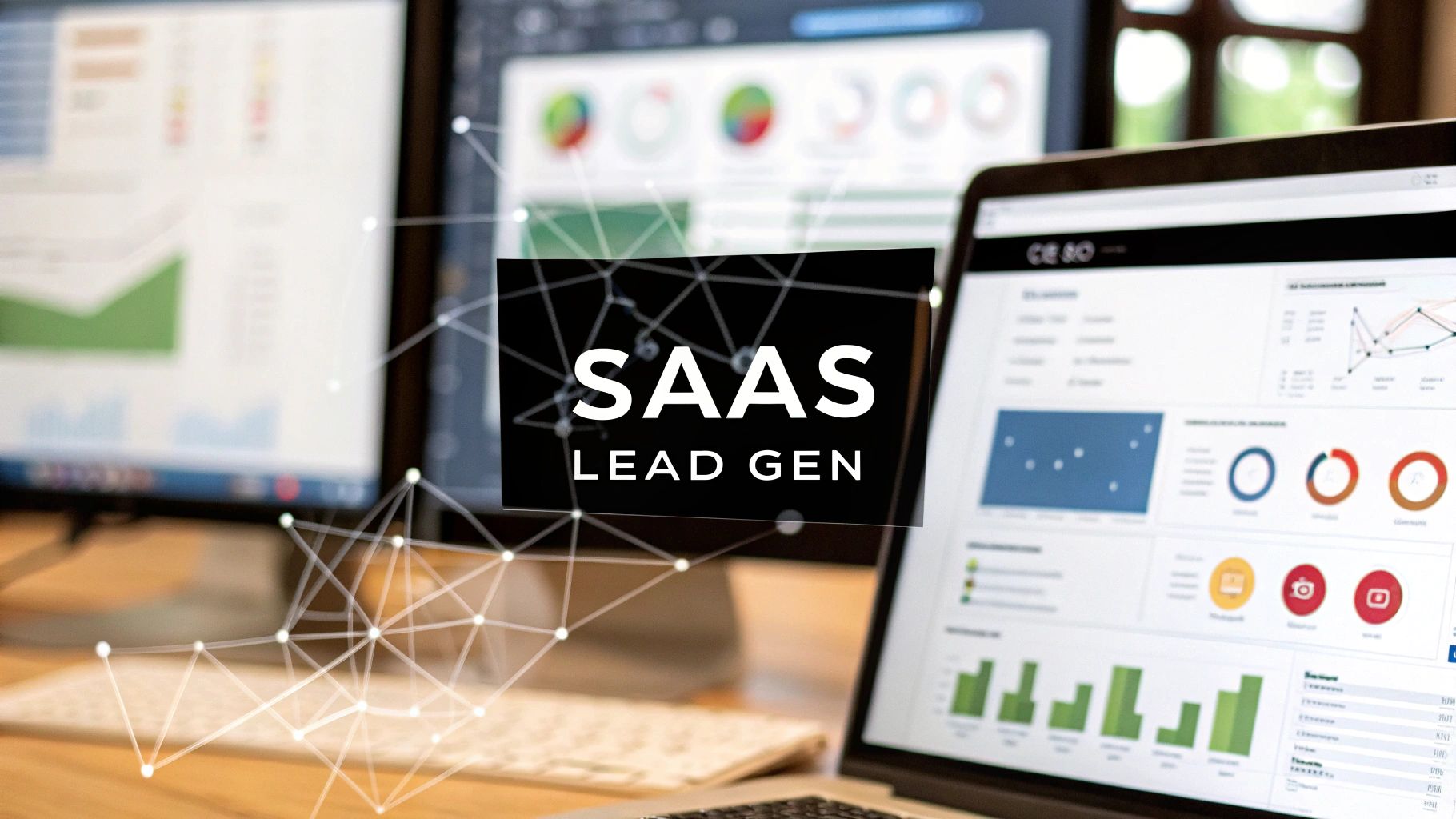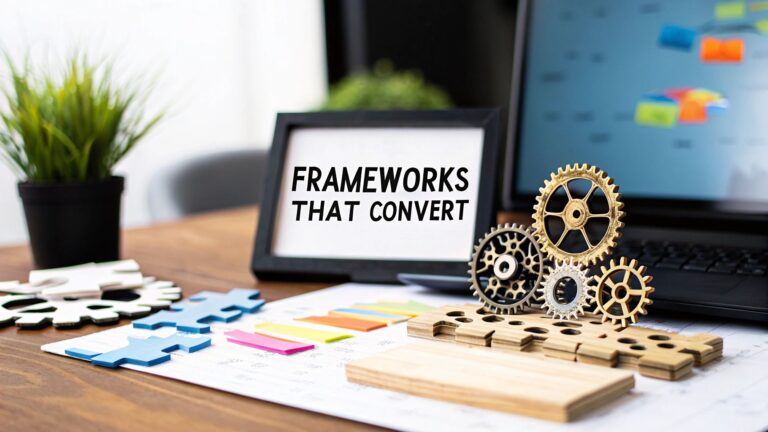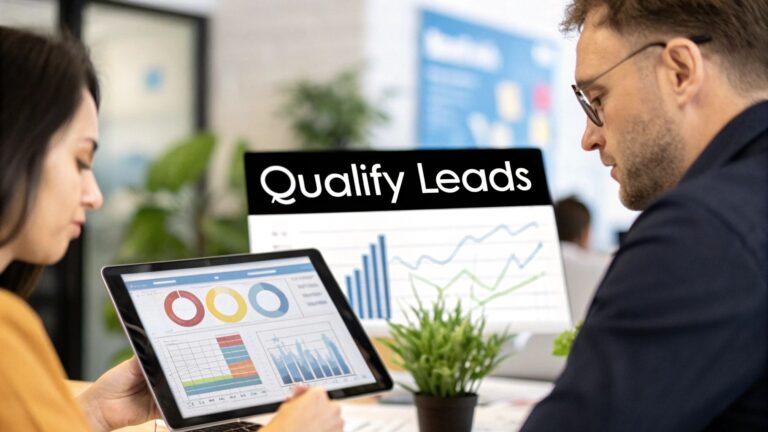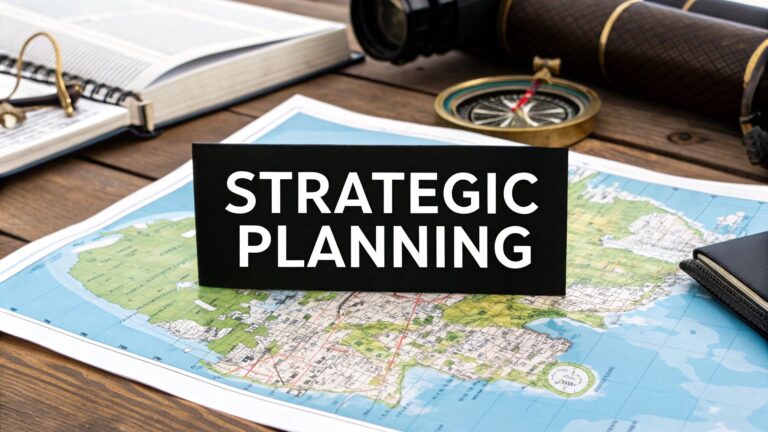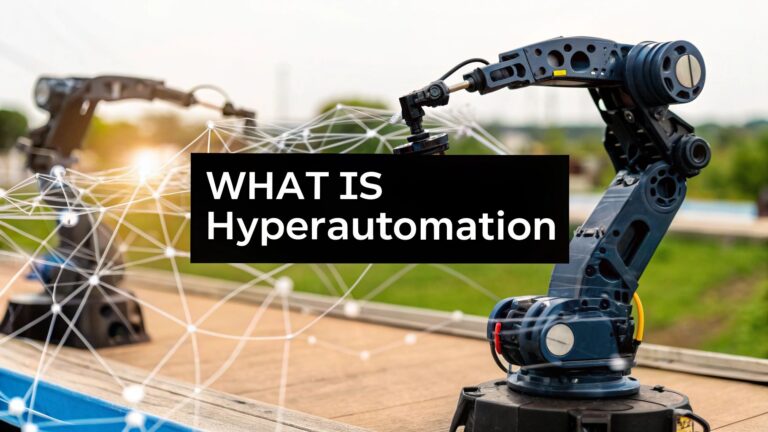12 Proven SaaS Lead Generation Strategies for 2025
In the competitive SaaS landscape, a steady stream of qualified leads isn't a luxury; it's the engine of sustainable growth. But with countless channels and tactics available, identifying where to focus your efforts for maximum impact can be a significant challenge. This guide is designed to cut through the noise, providing a clear and actionable framework for building a powerful lead generation machine.
We've compiled 12 battle-tested SaaS lead generation strategies that high-growth companies use to consistently fill their pipelines. This playbook covers a range of essential tactics, from long-term brand plays like content marketing to high-intent, targeted approaches like Account-Based Marketing (ABM) and strategic paid advertising. For a comprehensive approach to leveraging search engines, explore this proven SEO playbook for SaaS companies.
Whether you're a startup searching for your first 100 customers or a scale-up aiming to accelerate your market share, these strategies offer a definitive roadmap. Each point is designed to help you attract, engage, and ultimately convert your ideal customers. Let's dive into the practical tactics that will transform your lead generation from a constant struggle into a core business strength.
1. Master Content Marketing & SEO for Sustainable Growth
Content marketing and SEO form the bedrock of many successful SaaS lead generation strategies. This approach involves creating and distributing valuable, relevant content to attract and retain a clearly defined audience. By optimizing this content for search engines, you draw in qualified traffic from prospects actively seeking solutions like yours, establishing your brand as a trusted authority.
This strategy shifts the focus from outbound interruption to inbound attraction. Instead of chasing leads, you create a content engine that works 24/7, pulling potential customers into your ecosystem. Companies like HubSpot built their entire empire on this principle, offering extensive blogs, ebooks, and free tools that address their audience's pain points.

Actionable Implementation Tips
- Target Search Intent: Focus on answering the specific questions your ideal customers are typing into Google. Create content that directly solves a problem or provides a clear answer.
- Use the Pillar-Cluster Model: Develop a comprehensive "pillar" page on a broad topic (e.g., "SaaS Sales Funnels"). Then, create multiple "cluster" articles on related subtopics (e.g., "Top-of-Funnel Content Ideas") that all link back to the pillar page. This structure signals topic authority to search engines.
- Optimize for Long-Tail Keywords: Instead of targeting highly competitive terms like "CRM," aim for more specific, less competitive phrases like "CRM for small real estate agencies." These keywords often have higher conversion intent.
- Embed Clear CTAs: Every piece of content should guide the reader to the next step. Include clear calls-to-action (CTAs) that prompt them to download a resource, start a free trial, or book a demo.
2. Account-Based Marketing (ABM) for High-Value Targets
Account-Based Marketing (ABM) flips the traditional lead generation funnel on its head. Instead of casting a wide net to capture as many leads as possible, ABM is a focused strategy that concentrates sales and marketing resources on a defined set of high-value target accounts, treating each one as a market of one.
This approach aligns sales and marketing teams to create highly personalized campaigns designed to resonate with specific companies and their key decision-makers. Rather than waiting for inbound interest, you proactively target best-fit accounts. Companies like Terminus and 6sense have pioneered this methodology, helping B2B organizations orchestrate complex, multi-channel campaigns that engage entire buying committees within their most coveted future customers.
Actionable Implementation Tips
- Start with a Pilot Program: Don't try to boil the ocean. Begin with a manageable list of 20-50 ideal target accounts to refine your process before scaling.
- Identify Best-Fit Accounts: Use firmographic data and predictive analytics to create an Ideal Customer Profile (ICP). Identify accounts that match this profile and have the highest revenue potential.
- Coordinate Multi-Channel Messaging: Ensure your messaging is consistent and personalized across all touchpoints, from targeted ads and email outreach to direct mail and sales calls.
- Measure Account Engagement: Shift your focus from individual lead volume to overall account engagement. Track metrics like time spent on site, content downloads by multiple stakeholders, and meeting bookings from the target account. Learn more about B2B customer acquisition strategies on makeautomation.co.
3. Free Trial & Freemium Models
Free trial and freemium models are quintessential product-led SaaS lead generation strategies that lower the barrier to entry. Instead of telling prospects about your product's value, you let them experience it directly. This approach turns your software into its own best marketing tool, allowing users to discover its benefits firsthand and build trust before making a purchase.
This strategy effectively replaces traditional sales friction with a self-service experience. Companies like Slack and Canva became household names by offering a robust free version that encourages viral adoption and organic growth. The product itself becomes the primary driver for user acquisition, converting happy free users into paying customers who already understand the value proposition.
Actionable Implementation Tips
- Offer Frictionless Signup: Do not require a credit card for free trials. Allow users to sign up instantly using an email address or social login to maximize initial adoption.
- Implement Guided Onboarding: Use in-app tours, checklists, and tooltips to guide new users to their "aha!" moment. The goal is to ensure they experience the core value of your product quickly.
- Use Nurture Sequences: Create automated email sequences that educate trial users on key features, share success stories, and provide tips for getting the most out of the product. This keeps them engaged and moving toward activation.
- Show Clear Upgrade Paths: Clearly communicate the limitations of the free version and demonstrate the value of paid features. Use in-app prompts and notifications to highlight what they will gain by upgrading their plan. Learn more about how these models fit into your sales funnels at makeautomation.co.
4. LinkedIn Outreach & Social Selling
LinkedIn has evolved from a simple professional network into a powerhouse for B2B SaaS lead generation strategies. This approach centers on identifying key decision-makers, building authentic relationships, and initiating sales conversations through direct engagement. It combines targeted outreach with establishing authority, turning a social platform into a primary sales channel.
This strategy is highly effective because it allows you to connect directly with prospects in a professional context where they are open to business discussions. Instead of cold calling, you are engaging with individuals based on their roles, company signals, and content interactions. Companies like Lemlist and Clay have built entire toolsets around this principle, enabling hyper-personalized, scalable outreach that respects the prospect's time and delivers immediate value.
Actionable Implementation Tips
- Use LinkedIn Sales Navigator: Leverage its advanced filters to precisely target ideal customer profiles based on company size, industry, job title, and recent activity. This is non-negotiable for serious prospecting.
- Personalize Your First Message: Reference a shared connection, a recent post they engaged with, or a specific company achievement. Avoid generic, templated messages that scream automation.
- Engage Before Connecting: Like, comment on, or share a prospect's post before sending a connection request. This simple act warms up the interaction and significantly increases acceptance rates.
- Keep Outreach Short & Value-Focused: Your initial messages should be concise and centered on a potential benefit or insight for the prospect, not a sales pitch. Ask a relevant question to encourage a reply.
5. Host Engaging Webinars & Virtual Events
Webinars and virtual events are powerful, high-engagement SaaS lead generation strategies that allow you to connect with a large audience in a live, interactive format. By hosting educational sessions, product demos, or online conferences, you can showcase your expertise, address specific customer pain points, and build direct relationships with prospects. This approach generates highly qualified leads, as attendees invest their time to learn from you.
This strategy positions your brand as a go-to resource and a thought leader in your niche. Companies like Gong and HubSpot consistently use webinars to educate their audience on sales strategies and marketing automation, effectively nurturing potential customers through the sales funnel. A well-executed virtual event captures valuable lead data and provides a platform to directly demonstrate your product’s value.

Actionable Implementation Tips
- Solve a Specific Pain Point: Choose webinar topics that directly address a pressing challenge for your ideal customer profile. This ensures relevance and drives registrations.
- Promote Extensively: Start promoting your event 3-4 weeks in advance using email marketing, social media, and targeted paid ads to maximize attendance.
- Gate Content for Lead Capture: Require registration to access the live event. This simple step turns attendees into actionable leads for your sales team to follow up with. To ensure your virtual events are impactful and seamless, choosing from the best virtual conference platforms is a crucial first step.
- Repurpose Your Content: Record every webinar and repurpose it into blog posts, social media clips, and on-demand videos. Send the replay link to all registrants, including those who didn't attend live.
6. Email Marketing & Nurture Sequences
Email marketing is far from dead; for SaaS, it remains one of the most effective channels for converting leads into customers. This strategy involves building a targeted email list and deploying automated nurture sequences to guide prospects through the sales funnel with personalized, timely messaging. It’s about building a relationship, not just sending promotions.
This approach allows you to stay top-of-mind and educate leads who aren't ready to buy immediately. By delivering value directly to their inbox, you build trust and demonstrate your product's ability to solve their problems. Companies like ConvertKit and HubSpot have mastered this, using sophisticated workflows to segment users and deliver hyper-relevant content that drives high engagement and conversions.
Actionable Implementation Tips
- Segment Your Audience: Group subscribers based on behavior, role, or where they signed up. A lead from a webinar needs different content than one who downloaded a case study.
- Create Value-Driven Sequences: Design an automated series of emails that educates, addresses pain points, and showcases your solution's benefits. Each email should build on the last. To dive deeper into this topic, you can learn more about lead nurturing on makeautomation.co.
- Personalize Beyond the First Name: Use dynamic content based on the data you've collected. Mention their industry, company size, or specific features they've shown interest in on your website.
- Focus on a Single, Clear CTA: Each email should have one primary goal, whether it’s reading a blog post, watching a video, or booking a demo. A single, clear call-to-action (CTA) prevents confusion and increases click-through rates.
7. Build Strategic Partnerships & Integrations
Building strategic partnerships allows you to tap into established, relevant audiences, creating a powerful channel for SaaS lead generation strategies. This approach involves collaborating with companies that serve the same customer profile but offer complementary, non-competing products. By integrating your platforms, you add value for both user bases and generate warm leads through mutual promotion.
This strategy transforms competitors into collaborators, creating a win-win ecosystem that drives growth. Giants like Salesforce built empires around their AppExchange, and Zapier’s entire business model is a testament to the power of integration partnerships. It’s a method of borrowing trust and reaching qualified prospects who are already using tools within your technology stack.
Actionable Implementation Tips
- Create an Integration Marketplace: Develop a dedicated section on your site showcasing all your tech partners. This serves as a resource for your customers and a valuable co-marketing asset for your partners.
- Launch Co-Marketing Campaigns: Start with low-lift activities like joint webinars, co-authored ebooks, or guest blog swaps. These initiatives build relationships and test the partnership's potential before committing to deeper technical integrations.
- Develop an Ideal Partner Profile: Just like with customers, define the characteristics of a perfect partner. Consider their audience size, market reputation, and technical capabilities to ensure alignment.
- Offer Partner Incentives: Create a formal partner program with clear benefits, such as revenue sharing, lead referrals, and dedicated support. This incentivizes partners to actively promote your product to their user base.
8. Paid Advertising (Google Ads, Facebook, LinkedIn)
Paid advertising offers a direct and scalable method to generate SaaS leads by placing your solution in front of a highly targeted audience. Unlike organic strategies that take time to build momentum, platforms like Google, LinkedIn, and Facebook allow you to reach potential customers with precision, based on their search intent, job title, company size, or interests.
This approach provides immediate visibility and control, making it an essential component of a diversified lead generation portfolio. For example, a B2B SaaS company could use LinkedIn Ads to target CTOs in the finance industry, while another might use Google Ads to capture users actively searching for "project management software for small teams." The key is to align the platform and targeting with your ideal customer profile for maximum ROI.
Actionable Implementation Tips
- Target High-Intent Keywords: On Google Ads, focus on keywords with strong commercial intent, such as "best CRM for startups" or "Salesforce alternative," to attract users ready to make a purchase decision.
- Create Dedicated Landing Pages: Never send paid traffic to your homepage. Design specific landing pages for each ad group that match the ad's message and have a single, clear call-to-action (CTA).
- Leverage Platform Strengths: Use LinkedIn for precise B2B professional targeting (e.g., job title, industry), Google for capturing search intent, and Facebook for targeting based on interests and business demographics.
- Implement Rigorous Tracking: Set up conversion tracking from the initial click to the final customer sign-up. This data is crucial for optimizing campaigns and proving the effectiveness of your paid SaaS lead generation strategies.
9. Referral Programs & Influencer Marketing
Referral and influencer marketing are powerful SaaS lead generation strategies that harness the trust and social proof of existing customers and industry leaders. This approach turns your happy users and respected figures into a voluntary sales force, generating high-quality leads through word-of-mouth recommendations and authentic endorsements.
This strategy capitalizes on the most powerful form of marketing: a trusted recommendation. Dropbox famously used a two-sided referral program to achieve viral growth, rewarding both the referrer and the new user with extra storage. Similarly, companies like ConvertKit partner with relevant influencers to tap into pre-built, engaged audiences, accelerating trust and adoption.
Actionable Implementation Tips
- Make Referrals Frictionless: Integrate a simple, one-click referral process directly into your product dashboard. The easier it is to share, the more likely users will do it.
- Incentivize Both Parties: Reward both the person referring and the new customer who signs up. This dual-sided incentive, used by Airbnb and Asana, significantly boosts participation rates.
- Partner with Micro-Influencers: Collaborate with influencers who have smaller, highly engaged niche audiences (10k-100k followers). Their recommendations often feel more authentic and carry more weight than those from mega-influencers.
- Provide Unique Tracking Links: Equip advocates and influencers with unique, trackable links or codes. This allows you to accurately measure ROI and automate reward fulfillment for each partner.
10. Prioritize Technical SEO for Foundational Strength
While content is king, technical SEO is the castle it lives in. This strategy involves optimizing your website's backend infrastructure and technical performance to improve search engine rankings. A technically sound site is easier for search engine bots to crawl and index, directly impacting your visibility and ability to attract organic traffic.
This isn't just about appeasing Google; it’s about user experience. A fast-loading, mobile-friendly, and secure website keeps visitors engaged, reducing bounce rates and signaling quality to search engines. Platforms like Moz and Semrush offer powerful tools for conducting technical audits, identifying issues like broken links, slow page speed, or crawl errors that could be silently sabotaging your lead generation efforts. It's a critical component of any holistic SaaS lead generation strategy.
Actionable Implementation Tips
- Conduct a Comprehensive Site Audit: Use tools like Ahrefs' Site Audit or Semrush's Site Health checker to identify and prioritize technical issues.
- Optimize Page Speed: Aim for a load time of under 2 seconds. Compress images, leverage browser caching, and minify CSS, JavaScript, and HTML.
- Ensure Mobile-First Indexing: Your site must be fully responsive and provide an excellent experience on mobile devices, as Google primarily uses the mobile version for indexing.
- Implement Structured Data (Schema Markup): Use schema to help search engines understand your content's context, which can result in rich snippets and enhanced visibility in search results.
- Monitor Core Web Vitals: Keep a close eye on Google's Core Web Vitals (LCP, FID, CLS) in Google Search Console to ensure you're meeting user experience benchmarks.
11. Case Studies & Social Proof
Nothing builds trust faster than demonstrating that others, just like your prospect, have already succeeded with your solution. Case studies and social proof are powerful SaaS lead generation strategies because they provide tangible evidence of your product's value, moving leads from consideration to decision. This approach shifts the conversation from your claims to your customers' verified results, making your marketing more credible and compelling.
This strategy works by alleviating risk and answering a prospect's core question: "Will this work for me?" Seeing a similar company achieve measurable success with your SaaS provides the confidence needed to take the next step. Companies like Salesforce and HubSpot master this by showcasing detailed customer stories that highlight specific challenges, the solutions they implemented, and the impressive, data-backed results they achieved.
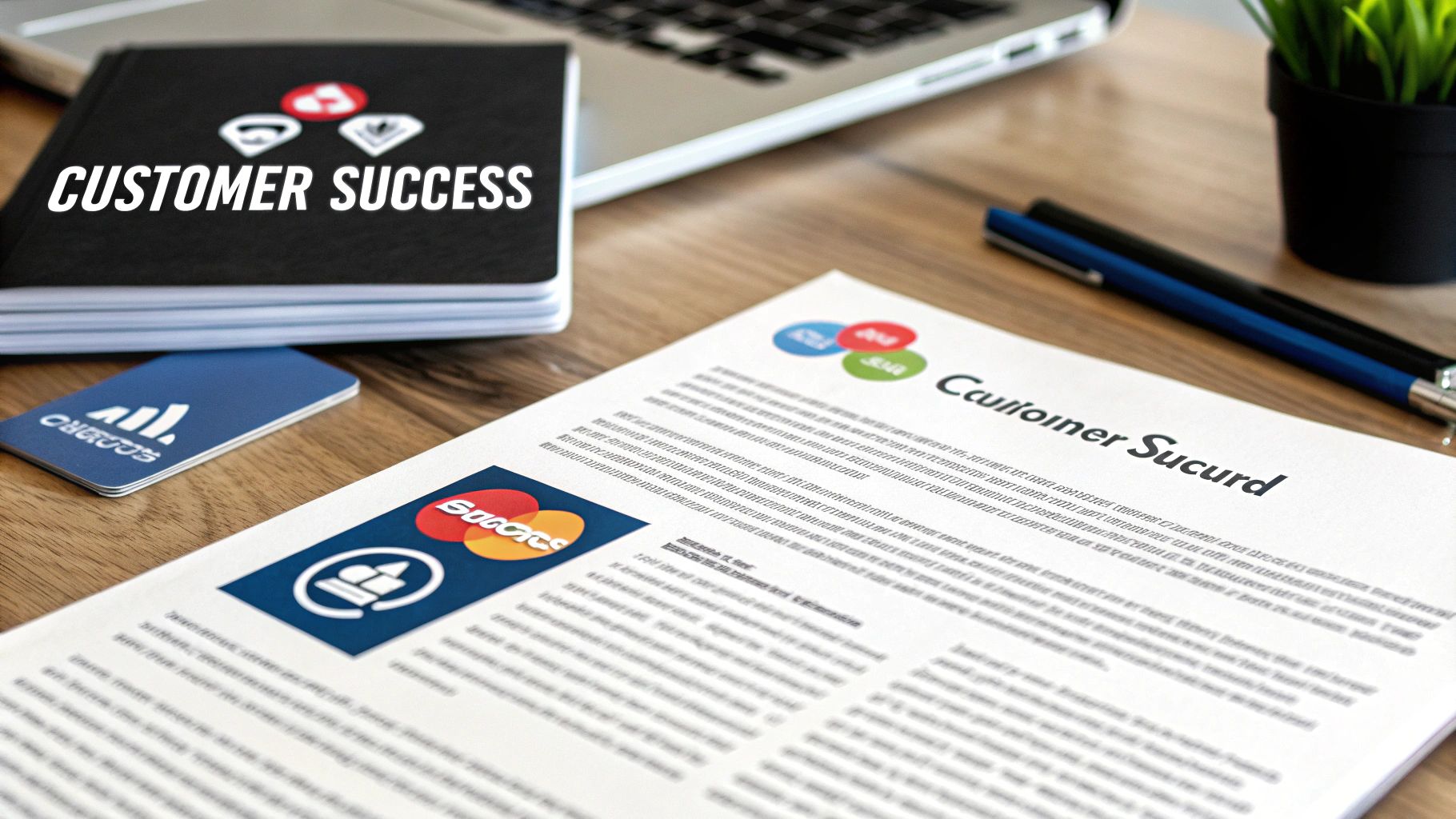
Actionable Implementation Tips
- Quantify Everything: Focus on case studies with hard numbers. Instead of saying "improved efficiency," state "Reduced processing time by 45%" or "Increased qualified leads by 200%."
- Leverage Third-Party Platforms: Actively encourage satisfied customers to leave reviews on sites like G2, Capterra, and TrustRadius. Embed these positive review widgets directly on your website.
- Create Video Testimonials: A short, authentic video of a happy customer explaining your product's impact can be far more persuasive than a written document. It adds a human element that builds an emotional connection.
- Display Customer Logos: Prominently feature the logos of well-known companies you work with on your homepage and pricing pages. This "borrowed credibility" instantly boosts your brand's authority.
12. Community Building & Thought Leadership
Building a community and establishing thought leadership are powerful, long-term SaaS lead generation strategies that create trust and authority. This approach involves positioning your brand and its key people as go-to experts in your industry. By consistently sharing valuable insights, you attract a loyal following that naturally converts into high-quality leads.
This strategy transcends direct selling by focusing on education and relationship-building. Instead of just marketing a product, you are marketing expertise and a vision. Salesforce's CEO, Marc Benioff, masterfully uses speaking engagements and his public platform to evangelize new ideas in business and technology, drawing immense attention and credibility back to the Salesforce brand.
Actionable Implementation Tips
- Create Original Research: Develop and publish unique industry reports or data-driven studies. This provides immense value and generates backlinks and media mentions.
- Pitch for Podcast Interviews: Identify relevant industry podcasts and pitch your executives as guests. This allows you to share your expertise with a pre-built, engaged audience.
- Be Active in Niche Communities: Participate authentically in relevant Slack channels, LinkedIn Groups, or online forums. Answer questions and offer help without a hard sell.
- Submit Speaking Proposals: Target industry conferences and events where your ideal customers are present. A well-delivered talk can establish instant credibility and generate significant inbound interest.
12-Strategy SaaS Lead-Gen Comparison
| Strategy | Implementation complexity | Resource requirements | Expected outcomes | Ideal use cases | Key advantages |
|---|---|---|---|---|---|
| Content Marketing & SEO | Medium–High (long-term program) | Content team, SEO tools, time | Sustainable organic traffic; qualified leads in 6–12 months | Inbound demand gen, brand authority, complex purchase cycles | High long-term ROI, authority, compounding traffic |
| Account-Based Marketing (ABM) | High (account-level personalization) | Sales‑marketing alignment, intent data, ABM tools | Higher conversion rates and larger deal sizes | Enterprise B2B, high-ACV target accounts | Focused ROI, shorter enterprise cycles, tailored outreach |
| Free Trial & Freemium Models | Medium (product-led ops) | Product readiness, infrastructure, onboarding resources | Rapid signups, behavioral data; 3–7% paid conversion typical | Self-serve SaaS, product-led growth, viral adoption | Low friction adoption, strong advocacy, lower CAC |
| LinkedIn Outreach & Social Selling | Medium (manual personalization) | Sales reps, Sales Navigator, time for outreach | High-quality B2B leads; response rates ~5–15% | Executive prospecting, account development, professional services | Direct access to decision-makers; relationship-driven conversions |
| Webinars & Virtual Events | Medium–High (event planning) | Event production, promotion budget, speakers | High-quality leads and engagement; attendees → conversations ~2–5% | Product demos, thought leadership, demand nurturing at scale | Authority building, scalable lead capture, reusable content |
| Email Marketing & Nurture Sequences | Low–Medium (automation setup) | Clean lists, automation platform, copywriting | Consistent, measurable conversions; very high ROI potential | Lead nurturing, onboarding, retention, upsell campaigns | Cost-effective, highly measurable, personalized at scale |
| Partnerships & Integrations | Medium (coordination & dev) | Dev resources, partner marketing, legal agreements | Expanded reach and distribution; can 2–5x leads via partners | Ecosystem growth, complementary product audiences, marketplaces | Access partner audiences, shared costs, credibility boost |
| Paid Advertising (Google/Facebook/LinkedIn) | Medium (campaign ops) | Ad budget, optimization skills, tracking infrastructure | Immediate traffic and leads; scalable but costly (varies by CPC) | Rapid demand generation, market testing, remarketing | Fast visibility, granular targeting, measurable ROI |
| Referral Programs & Influencer Marketing | Low–Medium (program setup) | Incentives, program admin, influencer fees | Low CAC, high-converting warm leads; viral growth potential | Consumer virality, SMB growth, advocacy-driven channels | Lowest CPA, high-quality referrals, network effects |
| SEO & Technical Optimization | Medium (technical work) | Technical SEO expertise, dev time, monitoring tools | Improved search visibility and UX; cumulative results over time | Sites needing speed/indexability; foundation for organic growth | Better rankings, faster pages, improved user engagement |
| Case Studies & Social Proof | Low–Medium (content production) | Customer collaboration, writing/video resources | Strong lift in conversions (30–50% cited); builds trust | Mid/late-funnel, enterprise sales, proof for skeptical buyers | Demonstrable credibility, sales enablement, reusable assets |
| Community Building & Thought Leadership | High (consistent, ongoing) | Executive time, content, events, PR effort | Long-term inbound interest and authority; slow ROI (6–12 months) | Brand positioning, recruiting, enterprise trust-building | Lasting credibility, relationships, earned media and visibility |
Automate and Accelerate Your Lead Generation Engine
You now have a comprehensive playbook of twelve powerful SaaS lead generation strategies, each capable of fueling significant growth. From the foundational pillars of Content Marketing and SEO to the targeted precision of Account-Based Marketing and the engaging power of Webinars, the path to a consistent lead flow is clear. Yet, the secret to sustainable success isn't just knowing these tactics; it's about architecting an integrated and scalable system.
True mastery comes from strategic implementation, not a scattergun approach. Trying to execute all twelve strategies at once is a recipe for burnout and diluted results. The most successful SaaS companies start by selecting two or three channels that align perfectly with their ideal customer profile and product value. They go deep, optimizing every detail until those channels become predictable and profitable lead sources before expanding to the next.
Key Takeaways for Building Your Growth Engine
Remember that effective SaaS lead generation is a marathon, not a sprint. The strategies we've explored, from building communities to nurturing leads with sophisticated email sequences, all rely on one core principle: consistency. Whether you are publishing content, engaging on social platforms, or refining your freemium model, persistent, high-quality effort is what builds momentum and trust.
To truly scale these efforts and prevent your team from being overwhelmed by manual tasks, automation is non-negotiable. An effective system ensures that your efforts compound over time rather than just adding to a daily to-do list.
Here are your actionable next steps:
- Audit and Select: Review the twelve strategies and identify the two or three with the highest potential impact for your specific audience and business model. Where can you get the quickest wins while also building long-term assets?
- Create a Pilot Program: For each chosen strategy, define clear goals, key performance indicators (KPIs), and a 90-day action plan. Treat it as an experiment to validate its effectiveness before committing more resources.
- Integrate and Automate: Map out how your chosen strategies will work together. How will leads from a webinar be entered into a nurture sequence? How can you automate LinkedIn outreach follow-ups? This is where you build the "engine" that runs on its own.
Ultimately, a well-oiled lead generation machine frees up your team to focus on what humans do best: building relationships, understanding customer needs, and closing high-value deals. By transforming these individual SaaS lead generation strategies into an interconnected and automated system, you're not just finding leads; you are building a predictable and powerful revenue pipeline that will drive your company’s growth for years to come.
Ready to turn these strategies into a fully automated lead generation machine? At MakeAutomation, we build the AI and automation frameworks that power scalable growth, from streamlined CRM workflows to intelligent email nurturing. Book a discovery call with MakeAutomation to see how we can build the systems that let you focus on closing deals, not just finding them.

